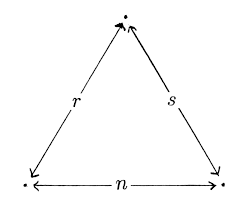| æ
ç è |
n
r s |
ö
÷ ø |
= (-1)s | æ
ç è |
-r-1
-n-1, s |
ö
÷ ø |
if n<0, r < 0, s ³ 0. (1.8) |
|
We complete the Pascal Hexagon in the obvious way by setting
We note the following properties of
Symmetry Identity
|
|
Pascal Identity
except that
Of course, the exception here is not bothersome as it is concerned with the only occurrence of the Pascal relationship which is not contained in a single sextant of the hexagon. Certain qualitative features of the Pascal Hexagon are shown in Figure 1(a). Notice the directions in which n, r and s are constant (Figure 1(b)) and the natural division of the hexagon into 6 triangular sextants. Three of these are non-zero sextants, labelled I, II, III, in which every entry is non-zero; and three are zero sextants, labelled Z1, Z2, Z3, in which every entry is zero. Note that the frontier lines between sextants are all regarded as belonging to the non-zero sextants they abut, except that the center point belongs to I. 

We suggest you take a few minutes to look at the portion of the Pascal Hexagon we give in Figure 1. In particular, compare the numbers (with their signs) that occur in the northeast and northwest sectors with those that occur in the ordinary Pascal Triangle. You may then see a very easy way to build the hexagon out of the Pascal Triangle. 
There are fascinating patterns within each non-zero sextant of the Pascal Hexagon. However, we are principally concerned in this paper with patterns which cross the sextants of the Pascal Hexagon. 1 If the entries for r and s are such that confusion might result we will insert a comma and write
|